TABLE
OF CONTENTS |
Part I
Dedicating the Temple
The Church Concept of God
|
Part III
(3) The Man with the Writer's
Inkhorn
—The Second Assignment
(4) The Dedication of Ezekiel's Temple
|
Part II
(1) The Dedication of the Tabernacle
—Bringing Home the Ark
(2) Solomon's Temple
—Dedicating the Temple
before It Was Finished |
Part IV
(5) God's True Temple
—"Filled with Smoke from
the Glory of God"
—What Happens Next?
—What Does the Dedication
of the True Temple
Portend?
—Why Is the Dedication of
God's Temple Important?
|

Part II
(1) The Dedication of the
Tabernacle
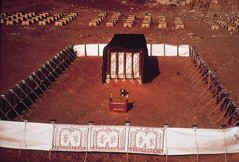
The Tabernacle |
God had commanded Moses to build Him a Tabernacle where He would meet with Israel.
While it was very beautiful on the inside, the tabernacle was very
plain in outward appearance—you might say, disappointing.
It looked like a big box, coffin like, covered with sealskins.
Not much to look at.
|
In that the people never really saw the inside of the
Tabernacle, it seems to have become very commonplace in later years and neglected. It did
not take long to build either. We read in Exodus 40:17
(ASV):
"And it came to pass in the first month in the second year, on the first day of
the month, that the tabernacle was reared up."
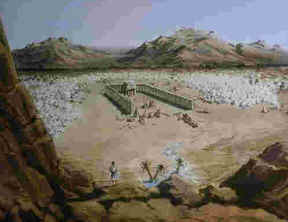
Construction of Tabernacle |
It took
about three months to get from Egypt to Mt. Horeb, the Mount of God.
Moses was up in the mountain forty days.
When he came down from the mountain he lay prostrate before the Lord
another forty days.
Then Moses went up into the mountain the second time for forty days.
This comes to about five months to construct the tabernacle.
|
How long did it take to put the
Tabernacle together once it was made?
One day. We just read in Exodus 40:17 that the Tabernacle was reared up on the "first
day of the month."
"Then a cloud covered the tent of the congregation, and the glory of the Lord
filled the tabernacle.
"And Moses was not able to enter into the tent of the congregation, because the
cloud abode thereon, and the glory of the Lord filled the
tabernacle."
Exodus
40:34, 35
The Israelites were not familiar with the pillar of fire by night
and the cloud by day until the Tabernacle was dedicated. Numbers 9:15, 16 reads:
"On the day that the
tabernacle was reared up the cloud covered the
tabernacle,
namely, the tent of the testimony: and at even there was upon the
tabernacle as it were
the appearance of fire, until the morning.
"So it was alway; the cloud covered it by day, and the appearance of
fire by night."
|
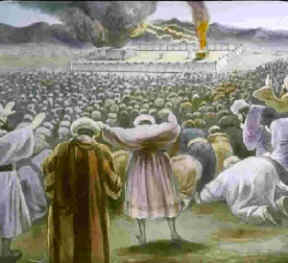
God’s glory was manifest not only
within the Tabernacle to the priests,
but also to the whole nation
by reason of the pillar of the cloud and fire. |
The
Tabernacle could not be used for its intended purpose until it
was dedicated and filled with the "smoke of God’s glory." This became a
witness to everyone in Israel, especially to Moses and the Priests and Levites.
It must have been awesome standing there in such glory.
Perhaps a
trembling came upon them, as they realized God was meeting with them there. While He was
not visible to them, His power and majesty were felt.
No one thereafter could doubt this whole arrangement was from God. When
they had complied with all the requirements in building it, God accepted their labors and
sacrifices and was pleased to meet with them there.
We shall see that God dedicates every
Temple or Tabernacle, temporal
or spiritual, before it is used for its intended purpose. God does not have many
ceremonies, but this is one ceremony He consistently employs without exception. So we do
well to take note of it.
We notice the blessings of the
Tabernacle arrangement could not be
invoked or any sacrifices be offered up until the dedication was completed. There was a
time pause here in which God’s glory was manifested and His approval was given. This
is most important.
Unless it can be demonstrated that God’s glory is dwelling
therein, any edifice or building would lack the credentials it needs to represent God. Men
can build all the temples in the world, lavished with gold and silver and jewels, but
unless they have evidence of God’s glory within they are nothing.

Preparing to Bring Home the Ark
Next, we look at Solomon's
Temple. The Tabernacle had lost its place
among the children of Israel. It had been housed at Shiloh through most of the period of
the Judges, but came into disrepair and soon just the Ark and some of the holy articles
were in order.
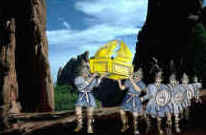
Philistines Capturing the
Ark of the Covenant |
Their troubles started when they took the Ark of Covenant onto the battlefield thinking
God would have to save it and them in that battle.
But, lo and behold, to their amazement the Lord allowed the
Philistines to capture it.
The Lord plagued the Philistines all the while they kept it, so they
sent it back on a wooden cart pulled by two cows.
|
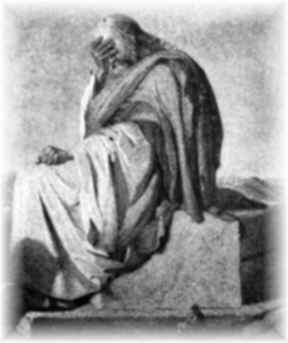
Eli hears about the Ark being
captured by the Philistines. |
The
Ark was taken by the Philistines during the closing
days of the Judges.
When Eli heard the Ark had been taken in battle, he fell over and died.
From this time on the Tabernacle began to languish.
Saul did nothing to restore it to its former glory.
|
David, had built himself a splendid house on Zion’s hill.
As he sat in such splendor he realized the Ark and the Tabernacle were not being used. He
wanted to bring the Ark from where it was housed at Kiriath-jearim
(ESV).
With much fan-fare they placed the Ark on a new cart and started out
toward Jerusalem. You remember how, as the Ark began to shake, Uzzah tried to steady it.
We read:
"He died there before God.
"And David was displeased, because the Lord had made a breach upon Uzzah."
1 Chronicles 13:10,11
Sometimes our good intentions turn into disaster. Indeed, David
meant well. Why would the Lord seemingly rebuke him before the whole nation even while his
heart was right before the Lord? Then we read:
"David was afraid of God that day; saying, How shall I bring the ark of God
home to me?"
1 Chronicles 13:12
This is a question he should have asked at the outset. Sometimes it
takes us a while to find what we must do.
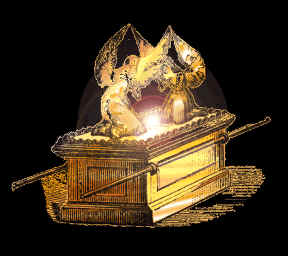
Ark of the Covenant |
Because of the tragedy, David had placed the Ark in the house of Obededom, the nearest
place he could find after Uzzah’s death. While the Ark was there we read:
"The Lord blessed the
house of Obededom, and all that he had."
1
Chronicles 13:14
|
When the Ark was held by the Philistines it only brought them
plagues and death. The same Ark brought blessings to Obededom’s household. How
beautiful! It is a principle, "Those that honor me I will honor."
Obededom’s heart was right before the Lord, and he and his house
reverenced the Ark and treated it with holy devotion. What a blessing came to him and his
house.
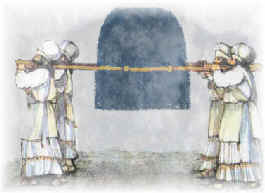
Only the Levites were to carry
the Ark of the Covenant. |
"David made him houses in the city of David, and prepared a place for the ark of God,
and pitched for it a tent.
"Then David said, None ought to carry the ark of God but the Levites:
for them hath the Lord chosen to carry the ark of God, and to minister unto him for
ever."
1 Chronicles 15:1, 2
|
This information was available to David before, but
in his haste to bring home the Ark he did not seek guidance from the Lord. This is a
lesson we may all learn as well. Good intentions are not enough.
David had Asaph and his brethren sing that wonderful song on the day
they delivered the Ark into its tent in Jerusalem. It is when the antitypical Ark is
finally brought to its place that true meaning of 1 Chronicles 16:31-34 will be realized.
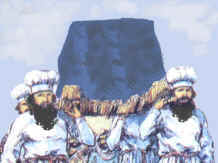
Carrying the Ark |
"Let the
heavens be glad, and let the earth rejoice: and let men say among the nations, The Lord
reigneth.
"Let the sea roar, and all the fulness thereof: let the fields
rejoice, and all that is therein.
"Then shall the trees of the wood sing out at the presence of the
Lord, because he cometh to judge the earth.
"O give thanks unto the Lord; for he is good; for his mercy
endures for ever!"
1 Chronicles 16:31-36
|
Then will follow the blessings the Lord has so
abundantly in store for the world.

(2) Solomon's Temple
David now had the Ark in Jerusalem. We read in 1 Chronicles 17:1, 2:
"Now it came to pass, as David sat in his house, that David said to Nathan the
prophet, Lo, I dwell in an house of cedars, but the ark of the covenant of the Lord
remaineth under curtains.
"Then Nathan said to David, Do all that is in
thine heart; for God is with
thee."
David’s desire to bring the Ark to Jerusalem was frustrated for
a while until he learned how to do it properly. Now, he wanted to build a
Temple for the
Lord. Millions of people often desire to do something for the Lord. However, much of what
people want to do for God He does not want done. If only we could learn this lesson.
Think of all the great sacrifices being made every day and every year
through the centuries supposedly for the Lord’s glory. Most of it has not been for
His glory, and only a tiny portion was for His sake. Even Nathan was carried away by
David's largess in wanting to build a temple.
Well, we know the story. Nathan had no sooner left David’s
presence when the Lord turned him right around and told him to go to David and say:
"Thou shalt not build me an house to dwell in."
1 Chronicles 17:4
Twice David had started out to do something for the Lord, and twice
he met with negative results. Someone of lesser stature might have withdrawn in
discouragement. Just because our first efforts are not accepted is no sign to stop.
David had the right heart attitude and the right discipline in reading
God’s will. David could have said, "All right. I’ll just give up on this
whole idea." He could have become morose and discouraged and left off seeking the
Lord.
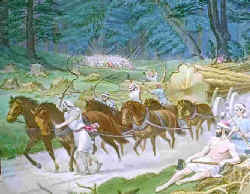 |
If
David could not build the house of the Lord, at least, he would make provisions for his
son, Solomon, whom God had said would build the Temple.
He set about gathering all the materials and resources that he could
husband to insure the speedy success of this task under Solomon.
|
He not only gathered supplies but he also arranged the
Priesthood into 24 courses to serve in the Temple and the Levites into 24 courses of
singers to serve in turn in the music of the Temple.
Now, you can see why David was a man after God’s own heart. Even
when rebuked and denied, he never lost heart but proceeded with dispatch in those areas
where he could serve. How many of the Lord’s people have lost blessings because when
they were not privileged to do things they aspired to do in the Lord’s service, they
decided not to serve at all.
Now it may seem that the
Temple and the new arrangements in the
service of the Temple were just David’s off-hand idea. Such is not the case. In 1
Chronicles 28:19 we learn:
"All this, said David, the Lord made me understand in writings by his hand upon
me, even all the works of this pattern."
Also in 2 Chronicles 29:25 it states:
"According to the commandment of David, and of Gad the king’s seer, and
Nathan the prophet: for so was the commandment of the Lord by his prophets."
(See also 1 Chronicles 28:11-18.)
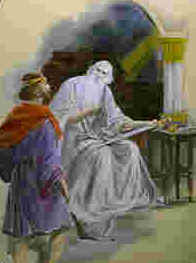
David and Solomon
|
The
Lord instructed David just as he did Moses.
The Lord made it clear how the Temple was to be built and how it would
be serviced.
David gave to Solomon what the Lord had given him in the way of
instructions.
|
In the fourth year of Solomon’s reign work on
the Temple was begun. Solomon began "to build in the second day of the second
month, in the fourth year of his reign" (2 Chronicles 3:2). It took nearly seven
and one half years to complete, after which it was dedicated.
Every edifice of God was always dedicated. Solomon’s Temple was no
exception. The building was unique in that it went together without the sound of a hammer.
All the cutting and shaping was done beforehand. When finally shaped and polished each
stone was placed in its respective place.
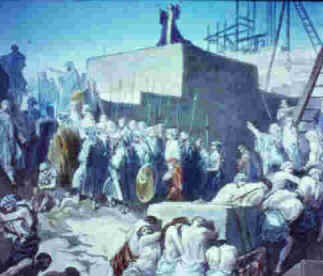
Building Solomon's Temple |
Every beam and piece of wood was cut and sanded and then placed in its setting. There was
no noise, no confusion, and no fanfare.
Everything was quietly and efficiently seated in its place, just as the
true Temple of God in this Gospel
Age is placed in the body of Christ.
|
Here, the Lord is putting together the most
magnificent Temple where He will dwell forever, and the world does not know what
is
going on. Because it is being done quietly, no one recognizes God’s work.
Oddly, the Temple seems to have been dedicated before it was completed.
In Reprint 5713 Bro. Russell says: "It was dedicated about a month before it was
completely finished. Doubtless this contained some important typical lesson, which we may
some day more fully understand." Actually, we learn the Ark was brought into the
Temple on the beginning of the seventh month. We read:
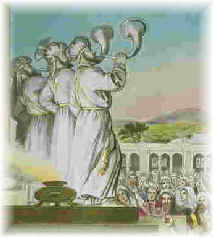
Priests Praising God
|
"Wherefore
all the men of Israel assembled themselves unto the king in the feast which was in the
seventh month." 2 Chronicles 5:3
That is when the Ark was brought to the Temple. Then as the singers were praising and
thanking God, we read: "That then the house was
filled with a cloud,
even the house of the Lord.
"So that the priests could not stand to minister by
reason of the cloud: for the glory of the Lord had filled the house of God." 2
Chronicles 5:13, 14 |
We learn in 2 Chronicles 7:10, 11:
"And on the three and twentieth day of the seventh month he sent the people
away into their tents, glad and merry in heart for the goodness that the Lord had shewed
unto David, and to Solomon, and to Israel his people.
"Thus Solomon finished the house of the Lord, and the king’s house."
This makes it about really three weeks difference before the
dedication started and when it is declared finished.
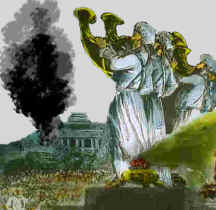 |
Perhaps the priests were startled by this event. Especially, the fact that it was a
"dark cloud."
Usually, we associate darkness with evil and trouble but not in this
case.
Solomon says:
"The Lord hath said that he would dwell in the thick
darkness."
2 Chronicles 6:1
|
In 1 Kings 8:12 we read:
"The Lord [has set the sun in the heavens, but has] said that he would
dwell in the thick darkness."
This is something of an enigma. The Hebrew does not sustain
"The Lord has set the sun in the heavens," but He did say
He "would
dwell in the thick darkness." Just before the Church, the Christ of God, "shine
forth as the sun in the Kingdom of their Father," it is preceded by the Dedication
wherein God dwells in the thick "darkness."
Maybe we do not understand the full meaning of all this. In Reprint
3283 Bro. Russell suggests: "That which outwardly had the appearance of a cloud in
the Sanctuary on the mercy seat represented an extreme brightness, so great that the
priests could no longer remain in the Holy."
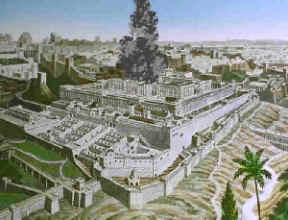
Dedication of Solomon's Temple |
Whether it was brightness in the Most Holy that made the cloud in the holy as a blinding
fog or whether indeed it was a "darkness" that was profoundly dense so that it
seemed impenetrable, we do not really know.
|
God’s presence was generally shown in the cloud above the
Tabernacle by day
and a pillar of fire by night. However, there is nothing said about this in regard to the
Temple.
At any rate there was a glory in this
Temple that left the priests with
the awesome realization of God’s presence and power. Perhaps the time of the
dedication of the true Temple will be a time of darkness in the world such, as was never
before, Armageddon darkness. At such a time as this God takes up His abode in His Holy
Temple.
"The Ark, representing typically the divine covenant with Abraham,
the fulfillment of which centered in the Christ, must be transferred from the
Tabernacle
to the Temple, that thus the latter might supersede the former as the meeting place
between God and his covenant people" (Reprint 3282, last paragraph). It is not,
therefore, until the Church is dedicated with the Ark being placed in it, that the
blessings of the Abrahamic Covenant will come to Israel and the world.

What Is the Meaning
in Dedicating the Temple
before It Was Finished?
Bro. Russell mused on what might be the meaning in the
Temple being
dedicated before it was completed, as the Scriptures we read earlier seem to indicate. He
says in Reprint 5714, last paragraph:
"The fact that the typical Temple was filled with the glory of the
Lord before it was entirely completed seems to imply that at this present time there will
be some manifestation of God’s favor toward His
Church in glorification while yet the
work of construction is not quite finished. However, it is difficult to read prophecy in
advance of its fulfillment. We must wait to see what will be the fulfillment of this
feature."
Bro. Russell is turning over in his mind what might be the
possible meaning here. We notice his great caution but none the less he suggests something
that seemed plausible to him. Yes, "there will be some manifestation of God’s
favor toward His Church in glorification while yet the work of construction is not quite
finished."
This very well might imply God’s favor would be manifested toward
His Church while some sealed members are on this side of the veil, just before they are
taken to glory. This would tie in very well with Bro. Russell’s expectation that the
saints would, while in the flesh, be instrumental in executing
"Vengeance upon the heathen, and punishments upon the people;
"To bind their kings with chains, and their nobles with fetters of iron;
"To execute upon them the judgment written: this honor have all his
saints."
Psalms 149:7-9